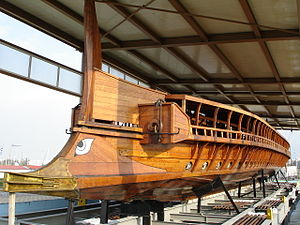- Olympias (trireme)
-
OlympiasCareer (Greece) 
Name: Olympias Owner: Hellenic Navy Ordered: 1985 Laid down: July 27, 1987 Launched: August 1987 Commissioned: August 26, 1987 Homeport: Faliron 37°56.057′N 23°41.11′E / 37.934283°N 23.68517°E Status: serves as exhibit in dry dock General characteristics Type: trireme Displacement: 70 tonnes Length: 36.9 m (121 ft 1 in) Beam: 5.5 m (18 ft 1 in) Draught: 1.25 m (4 ft 1 in) Propulsion: two large square sails
170 oarsmenSpeed: Maximum (with oars) over 9 knots (17 km/h)
Continuous (crew rowing in turns) 4.0 kilometres per hour (2.5 mph) (estimated)Complement: 200 plus 5 officers (in antiquity) Armament: bronze bow ram, ten spears, four archers Olympias is a reconstruction of an ancient Athenian trireme and an important example of experimental archaeology.
She was constructed from 1985 to 1987 by a shipbuilder in Piraeus. Finance came from the Hellenic Navy and donors such as Frank Welsh (a Suffolk banker, writer and trireme enthusiast). The building was advised by the historians J. S. Morrison and John F. Coates and the classics teacher Charles Willink, who with Welsh founded the Trireme Trust that initiated the project, and drew on evidence gained from underwater archaeology. The Trireme Trust is now chaired by Professor Boris Rankov (Royal Holloway University of London).
The bronze bow ram weighed 200 kg. The ship was built from Oregon pine and Virginia oak.
The important hypozomata (bracing ropes) had to be replaced by a steel rope as neither natural fibre ropes, nor synthetic fibre ropes with about the same elastic modulus as hemp could be obtained. Its tension varied as the hull bent on waves, rather than exerting a substantially constant tension like a natural fibre rope, and caused the alarming possibility of this causing the rope to snap and endanger the crew, so protective measures had to be fitted[1].
She was subject to sea trials in 1987, 1990, 1992 and 1994, but one of the most informative was an exercise in 1987 when crewed by 170 volunteer oarsmen and oarswomen. Olympias achieved a speed of 9 knots (17 km/h) and was able to execute 180 degree turns within one minute, in an arc no wider than two and a half (2.5) ship-lengths. These results, achieved with an inexperienced crew, suggest that the ancient writers were not exaggerating about the capabilities of such vessels.
Olympias was transported to Britain in 1993, to take part in events celebrating the 2,500 years since the beginning of democracy. In 2004 Olympias was used to transport the Olympic Flame ceremonially from the port of Keratsini to the main port of Piraeus, as the Olympic Torch Relay entered its final stages in the run-up to the 2004 Summer Olympics opening ceremony. She is now an exhibit in a dry dock in Faliron, Athens, Greece.
A trireme of the classical period would have had a crew of 200, including five officers. This would be made up of:
- trierarchos (τριήραρχος "commander of trireme") — the commanding officer, responsible for supporting the ship
- kybernetes (κυβερνήτης: κυβερνάω "steer") — executive officer, responsible for the cruising safety
- keleustes (κελευστής: κελεύω "command") — responsible for the training and morale of the crew
- pentecontarchos (πεντηκόνταρχος "commander of fifty") — administration officer
- prorates (πρῳράτης: πρῷρα "prow") — bow officer, responsible for keeping a sharp lookout
- 1 auletes (αὐλητής: αὐλός "flute") — a musician supplying the oar timing with his flute
- 170 oarsmen in three banks
- 62 thranites (θρᾱνῖται, singular θρᾱνίτης: θρᾶνος "bench") — the upper bank
- 54 zygites (ζυγῖται, singular ζυγίτης: ζυγόν "yoke", "rowing-bench") — the middle bank
- 54 thalamites (θαλαμῖται, singular θαλαμίτης: θάλαμος "inner chamber") — lower bank
- 10 sailors for handling the sails
- 14 Marines (10 spearsmen, 4 archers)
See also
 Media related to Olympias (ship, 1987) at Wikimedia Commons
Media related to Olympias (ship, 1987) at Wikimedia CommonsReferences
- ^ The 18th Jenkin Lecture, 1 October 2005: Some Engineering Concepts applied to Ancient Greek Trireme Warships
External links
- Relevant Page from Hellenic Navy
- Ships of the World: An Historical Encyclopedia
- The Trireme Trust
- Trireme Olympias underway (YouTube)
Coordinates: 37°56′3.3″N 23°41′7.14″E / 37.93425°N 23.6853167°E
Categories:- Ships of the Hellenic Navy
- Ships built in Greece
- 1987 ships
- Replica ships
- Museum ships in Greece
Wikimedia Foundation. 2010.

